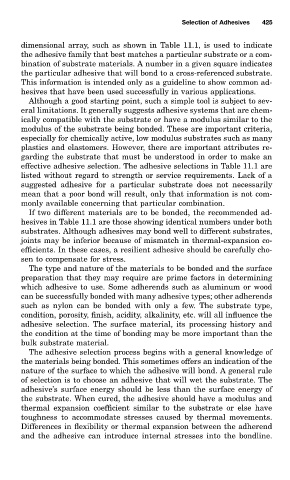Page 489 - Handbook of Adhesives and Sealants
P. 489
Selection of Adhesives 425
dimensional array, such as shown in Table 11.1, is used to indicate
the adhesive family that best matches a particular substrate or a com-
bination of substrate materials. A number in a given square indicates
the particular adhesive that will bond to a cross-referenced substrate.
This information is intended only as a guideline to show common ad-
hesives that have been used successfully in various applications.
Although a good starting point, such a simple tool is subject to sev-
eral limitations. It generally suggests adhesive systems that are chem-
ically compatible with the substrate or have a modulus similar to the
modulus of the substrate being bonded. These are important criteria,
especially for chemically active, low modulus substrates such as many
plastics and elastomers. However, there are important attributes re-
garding the substrate that must be understood in order to make an
effective adhesive selection. The adhesive selections in Table 11.1 are
listed without regard to strength or service requirements. Lack of a
suggested adhesive for a particular substrate does not necessarily
mean that a poor bond will result, only that information is not com-
monly available concerning that particular combination.
If two different materials are to be bonded, the recommended ad-
hesives in Table 11.1 are those showing identical numbers under both
substrates. Although adhesives may bond well to different substrates,
joints may be inferior because of mismatch in thermal-expansion co-
efficients. In these cases, a resilient adhesive should be carefully cho-
sen to compensate for stress.
The type and nature of the materials to be bonded and the surface
preparation that they may require are prime factors in determining
which adhesive to use. Some adherends such as aluminum or wood
can be successfully bonded with many adhesive types; other adherends
such as nylon can be bonded with only a few. The substrate type,
condition, porosity, finish, acidity, alkalinity, etc. will all influence the
adhesive selection. The surface material, its processing history and
the condition at the time of bonding may be more important than the
bulk substrate material.
The adhesive selection process begins with a general knowledge of
the materials being bonded. This sometimes offers an indication of the
nature of the surface to which the adhesive will bond. A general rule
of selection is to choose an adhesive that will wet the substrate. The
adhesive’s surface energy should be less than the surface energy of
the substrate. When cured, the adhesive should have a modulus and
thermal expansion coefficient similar to the substrate or else have
toughness to accommodate stresses caused by thermal movements.
Differences in flexibility or thermal expansion between the adherend
and the adhesive can introduce internal stresses into the bondline.

